Electronic Products for 1925
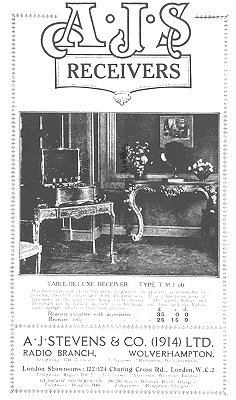 |
In 1925 the number of models was increases to ten,
and prices were again slightly reduced. The receivers were 2, 3
or 4 valve T.R.F's. There were also a number of other products,
including audio amplifiers, loudspeakers and headphones. The
picture opposite shows the front page of the 1925 radio
catalogue. The receivers were still aimed at the top end of the
market, as can be seen from the photograph on the front page. |
| The type 'Z', 2 valve
receiver was a very basic receiver, consisting of an aerial
tuned circuit, detector and single stage audio amplifier.
It was a table-top model, in a mahogany cabinet with lid, and
came complete with the loudspeaker. The receiver with all
accessories sold for £13.18s.6d. |
 |
| Read what A.J.S. had to
say about the receiver |
 |
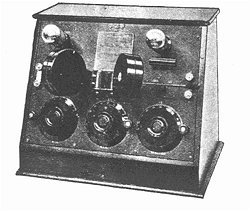 |
The A.J.S. 2 Valve Standard
Receiver, type 'D6', consisted of a tuned high frequency
amplifier and a detector. The receiver was not capable of
driving a loudspeaker and so headphones had to be used.
It was housed in an oak or mahogany, sloping panel case and
with all accessories, sold for £16.17s.6d. The receiver on its
own sold for £11.10s.0d. |
The following paragraph is from the sales literature:
"This is a moderately priced receiver for the man who
desires to listen to distant broadcast on telephones on any
wavelength from 150 metres upwards, according to the
longwave plug-in coils used. The first valve is a high
frequency amplifier, and is followed by a detector.
Provision has been made to allow the valves to be turned off
and on, and a wavelength switch is provided with three
positions, 'Short', 'Broadcast' and 'Long'. This model has
not been designed to operate a loudspeaker, and for this
reason the phone to loudspeaker switch has been dispensed
with. If, however, loudspeaker reception is desired, any one
of the A.J.S. amplifiers described in publication No.119 may
be connected across the telephone terminals. This model is
only made in one style of cabinet, and that is illustrated." |
| The A.J.S. 3 valve receiver type 'E6' consists of
a tuned high frequency amplifier, detector and single stage
audio amplifier. It is housed in an oak or mahogany, sloping
panel case, and sold for £14.17s.6d on its own, or £21.13s.6d
with all accessories.
The accessories included a pair of headphones, but a
loudspeaker had to be purchased separately. The receiver can
only drive a loudspeaker at a modest volume. If more volume is
required, an A,J.S. amplifier also had to be purchased. |
 |
 |
The A.J.S. 4 valve receiver type 'F6' consists of
a tuned high frequency amplifier, detector and two stage audio
amplifier. It is housed in an oak or mahogany, sloping panel
case, and sold for £18.10s.0d on its own, or £26.15s.0d with all
accessories.
It was basically the same as the 'E6', except that it could
provide a much higher sound level from a loudspeaker, due to the
extra audio amplifier stage. This receiver was available in a
variety of cabinets. |
| All A.J.S. receivers at the time used Mullard
valves. The plug-in resistors below each valve, in the
photograph above, allowed different valves with different
filament voltages, to be used, by inserting different values of
resistance.
The photograph opposite shows an A.J.S. table receiver type
'TM2', which is a 4 valve receiver, in an oak or mahogany table
top cabinet. The receiver, complete with accessories, sold for
£30.10s.0d., or on its own £21.5s.0d.
The receiver was also
available in an ornate mahogany case, and was called the Table
De Luxe Receiver, Type 'TM1'. The receiver with accessories sold
for £35, or £25.15s.0d for the receiver alone.
|
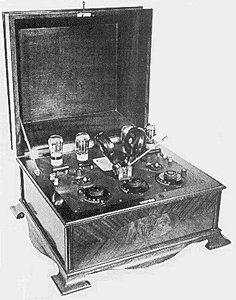 |
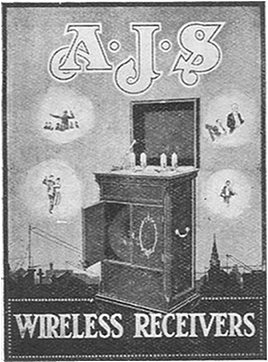 |
The following text is from the 1925
catalogue, which describe the A.J.S. 4 valve receivers:
"The A.J.S. 4-valve model has been designed
for those who desire to receive broadcast speech and music on a
loudspeaker, no matter in what part of the country they are
situated. The wavelength range of the
receiver is from 150 metres upwards, according to the long wave
plug-in coils used. The quality of the
reception obtainable from all A.J.S. receivers is far above the
average.
Most critical listeners have noticed that in
radio the low notes are usually flat and very often are entirely
lost. But with A.J.S. receivers these low notes all come through
with their full value and richness of tone, and this perfect
reproduction extends right up in the audible scale, and includes
every overtone, nothing is lost. |
| The result is truly remarkable and
is made possible by the choke method of coupling, which with
suitable valves, such as the A.J.S. Mullard, give equal volume
and considerably purer reproduction than the average transformer
coupling so generally used."
The receiver opposite is the A.J.S. Pedestal Receiver Type
'P2'. The 4 valve receiver was available in an oak or mahogany
cabinet, which included a horn loudspeaker and battery
compartment. The receiver with accessories sold for £52, or
£42.15s.0d. for the receiver alone. |
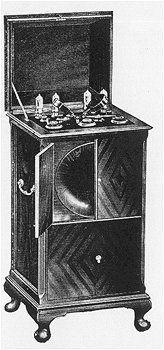 |
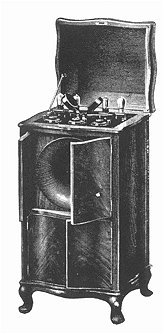 |
The A.J.S. Pedestal De Luxe Receiver Type 'P1'. This 4
valve receiver was enclosed in a mahogany cabinet, which
included a horn loudspeaker and battery compartment.
The receiver with accessories sold for £65, or
£55.15s.0d. for the receiver alone. |
| The 4 valve A.J.S. Consol Receiver Type 'S1' is
house in a fine mahogany cabinet, with centrally mounted
horn loudspeaker.
The two side cupboards are for batteries, headphones
and accessories.
The receiver and accessories sold for £75, or
£65.15s.0d for the receiver alone. |
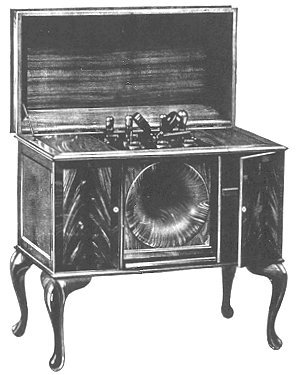 |
 |
The 4 valve A.J.S. Pedestal Cabinet receiver, was
available in oak or mahogany, with built in metal horn
loudspeaker and battery compartment.
The cost, complete with all accessories, was
£51.18s.0d. |
| A.J.S. Loudspeakers
Several versions of A.J.S. horn loudspeakers were produced.
The Standard Loudspeakers were 24" tall. The top of the range
model had oak or mahogany flares, and sold for £4.15s.0d. The
cheaper model had a metal horn, and was available in a black
matt or stove finish, for £4, or in a grained wood finish for
£4.5s.0d.
The Junior Loudspeakers were 19" tall, and had a
metal horn. The model with a wood grained finish
sold for £1.17s.6d., and the model with a black
finish sold for £1.15s.0d.
There was also an enclosed loudspeaker in a
mahogany cabinet, which was £4.15s.0d., or a
pedestal model in a mahogany or rosewood cabinet. It
sold for £22.10s.0d.
|
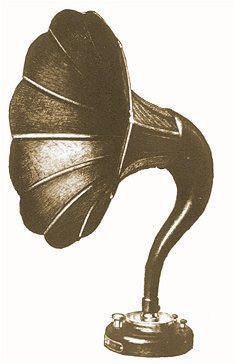
The wooden flare horn loudspeaker. |
|
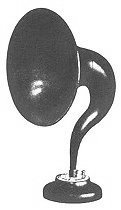
The Junior Model |
The following text is from the sales
literature: "For the benefit of
those who may consider the purchase of one of
the cabinet models, not containing a
loudspeaker, A.J.S. models may be had with
wooden flares in oak and mahogany.
If metal horns are preferred on account of cost,
or for any other reason, they may be had so
skilfully hand finished with colour and graining
that it is difficult to believe that they are
metal, The lowest priced loudspeakers have a
black crystalline finish. To those who desire
something different to the horn loudspeaker, we
would recommend our pedestal model, which in
addition to being an exquisite piece of
ornamental furniture, reproduces speech and
music with such fidelity that it is well-nigh
impossible to realise the fact that the sound
emitted by it is a reproduction." |
|
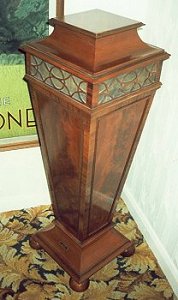 |
A pedestal loudspeaker.
Courtesy of |
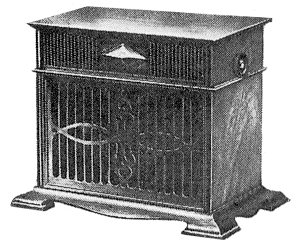
Cabinet Model. Photo courtesy of John
Chapman. |
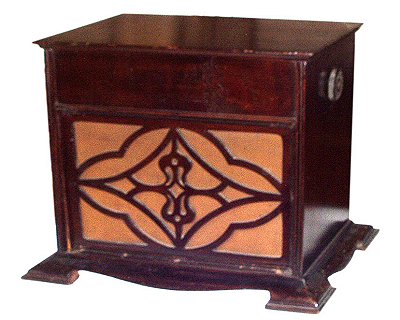 |
An A.J.S. model L.S.C.
horn loudspeaker.
Courtesy of Konrad Birkner
who is an administrator in the virtual
Radiomuseum website at
http://www.radiomuseum.org. |
| A view from the bottom
of the above loudspeaker.
Courtesy of Konrad Birkner. |
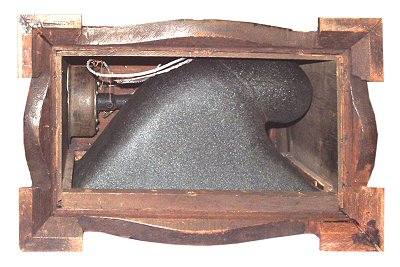 |
|

The A.J.S. plate on the
above loudspeaker. Courtesy of Konrad Birkner.
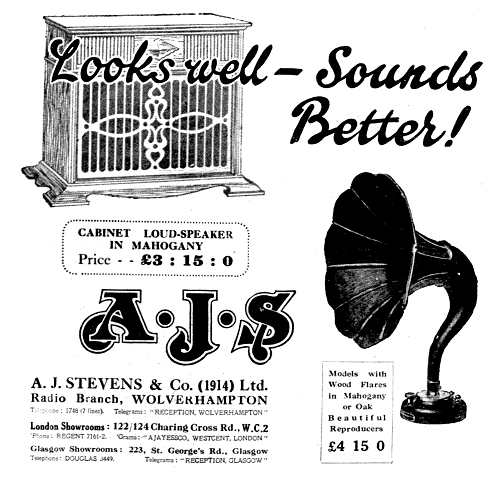 |
|
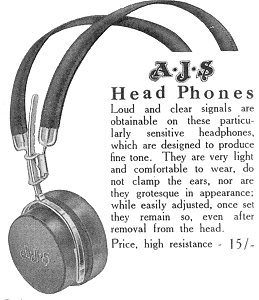
Photo courtesy of John
Chapman |
Although A.J.S. sold headphones they were
actually made elsewhere and "badged" with the
company's logo. |
| A.J.S. Amplifiers
A.J.S. produced a couple of audio amplifiers for
use with receivers that either couldn't drive
loudspeakers, or only had a low level of volume.
The 2 valve amplifier was housed in a table
top cabinet, with a lid that covered the valves.
It sold for £7.10s.0d.
There was also a larger model called the
'Concert Amplifier', which sold for £11.15s.0d. |

The two valve 'Concert' amplifier.
Photo courtesy of John Chapman. |
 |
The A.J.S. Patent
Rejector Circuit
This was used to remove interference from adjacent channels.
It operated over a range of 150 to 700 metres and sold for £2.5s.0d. |
|

|
|
Return to A.J.S.
Receivers |
|

